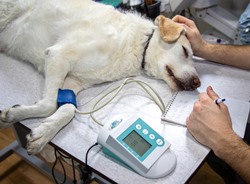Veterinary Technician Training
How to Enroll In the Right One Near Stanford California
 Choosing a veterinary technician school near Stanford CA to fulfill your lifelong goal to work with and care for our pets may initially seem like an enormous task. But in order to succeed as a working veterinary technician, you must first search for and finally enroll in a school that will provide the required training and education. But just how do you go about assessing and comparing colleges so that you can make the ideal choice? When checking out vet tech schools, the majority of students begin by zeroing in on the ones that are closest to their homes. Once they have found some local schools, they ascertain which ones have the lowest tuition and focus on those. Although location and expense are important considerations when evaluating vet tech programs, they are not the only important ones when making your comparisons. Qualifiers such as internship programs and accreditation need to be considered as well. The point is that there are questions you should be asking the vet technician schools you are considering before you make a final selection. We have provided several in this article to help get you started, but before we discuss them we'll discuss the various duties of veterinary technicians and the training options offered.
Choosing a veterinary technician school near Stanford CA to fulfill your lifelong goal to work with and care for our pets may initially seem like an enormous task. But in order to succeed as a working veterinary technician, you must first search for and finally enroll in a school that will provide the required training and education. But just how do you go about assessing and comparing colleges so that you can make the ideal choice? When checking out vet tech schools, the majority of students begin by zeroing in on the ones that are closest to their homes. Once they have found some local schools, they ascertain which ones have the lowest tuition and focus on those. Although location and expense are important considerations when evaluating vet tech programs, they are not the only important ones when making your comparisons. Qualifiers such as internship programs and accreditation need to be considered as well. The point is that there are questions you should be asking the vet technician schools you are considering before you make a final selection. We have provided several in this article to help get you started, but before we discuss them we'll discuss the various duties of veterinary technicians and the training options offered.
IT TAKES JUST A FEW MINUTES TO START YOUR VET TECH CAREER BELOW
Vet Technician Degree Options

Among the first decisions that you will need to make is if you wish to train as a vet technician, assistant or technologist. Part of your decision may be predicated on the amount of time and money that you have to commit to your training, but the principal factor will probably be which specialty appeals to you the most. What technicians and assistants share in common is that they all work under the immediate guidance of a licensed and practicing veterinarian. And even though there are a number of tasks that they can perform within the Stanford CA veterinary practice or hospital, they can't prescribe medications, diagnose conditions, or carry out surgical procedures. In those areas they can only provide support to a licensed veterinarian. There are technicians and technologists that work away from the standard veterinarian practice, such as for zoos, animal shelters or law enforcement. Let's take a look at the responsibilities and education requirements for each specialty.
- Vet Assistants in almost all instances will have undergone a formal training program, either as an apprentice or intern in a practice, or by graduating from a certificate program at a vocational school or community college. As the name implies, their job function is to assist the vets and vet technicians in the completion of their duties. Generally they are not involved with more complex undertakings, for instance assisting with surgical procedures. Some of their normal responsibilities may include working at the front desk, preparing and cleaning exam rooms and equipment, or handling animals during examinations.
- Vet Technicians receive more extensive training in contrast to assistants and normally obtain a 2 year Associate Degree, ideally from an American Veterinary Medical Association (AVMA) accredited program. They are in a sense the vet counterparts of medical nurses, since their general job function is to assist veterinarians with diagnosing and treating animal patients. Where they differ from vet assistants is that they are included in more complicated activities, for instance assisting with surgical procedures or providing medication. All states currently require veterinary technicians pass a credentialing exam for either licensing, registration or certification.
- Vet Technologists are comparable to veterinary technicians and for the most part perform the same work functions. They are required to obtain a Bachelor's Degree in veterinary technology, which normally takes four years. Therefore the main difference between a vet technician and a technologist is the technologist's higher level of education. But with an advanced degree comes more career opportunities, higher salaries and potential management positions. They are additionally required to pass a credentialing examination for either certification, registration or licensing.
Vet technicians and technologists may specialize in areas such as internal medicine, anesthesia or emergency care. Many may acquire certification from the American Association for Laboratory Animal Science (AALAS) to work in Stanford CA laboratories or research facilities as well.
Questions to Ask Vet Tech Schools
 At this point you should have determined which veterinarian degree that you would like to attain, and if you prefer to study online or attend a program on campus. Since there are a large number of veterinarian community colleges, vocational and technical schools in the Stanford CA area and across the Country, you should ask some qualifying questions in order to fine tune your list of alternatives. As we mentioned in our opening, many prospective students start by focusing on location and the cost of tuition. But we have previously pointed out other significant qualifiers, for example accreditation and internship programs. And of course you need to choose a school that offers the degree and specialty that you want to earn. These and other factors are reviewed in the checklist of questions that you should ask the veterinary technician programs that you are looking at.
At this point you should have determined which veterinarian degree that you would like to attain, and if you prefer to study online or attend a program on campus. Since there are a large number of veterinarian community colleges, vocational and technical schools in the Stanford CA area and across the Country, you should ask some qualifying questions in order to fine tune your list of alternatives. As we mentioned in our opening, many prospective students start by focusing on location and the cost of tuition. But we have previously pointed out other significant qualifiers, for example accreditation and internship programs. And of course you need to choose a school that offers the degree and specialty that you want to earn. These and other factors are reviewed in the checklist of questions that you should ask the veterinary technician programs that you are looking at.
Is the Vet Program Accredited? It's imperative that you confirm that the vet tech college you choose is accredited by a regional or national accrediting organization. As earlier discussed, among the most highly regarded is the American Veterinary Medical Association (AVMA). Vocational schools and colleges that are accredited by the AVMA have undergone an extensive screening process that confirms you will receive a quality education. Also, accreditation is necessary if you are requesting a student loan or financial assistance, since many programs are not available for non-accredited colleges. And finally, having a degree or certificate from an accredited program is often a precondition for employment for many Stanford CA area vet practices and hospitals.
What is the School's Reputation? The vet college or vocational school and program you enroll in should have an exceptional reputation within the veterinary community. You can initiate your due diligence by asking the schools you are reviewing for endorsements from the employers in their job assistance network. Other tips include checking with internet school ranking websites and speaking with the school's accrediting organizations as well. You can ask the California school licensing authority if there have been any complaints or infractions involving your specific schools. As a final recommendation, phone some Stanford CA veterinarians that you might want to work for after you get your training. Find out what they think of your school selections. They might even recommend some schools not on your list.
Are Internships Offered? The most effective means to get clinical hands on experience as a vet tech is to work in a professional setting. Ask if the schools you are looking at have internship programs established with Stanford CA veterinarians, vet hospitals or practices. Most veterinary medicine programs require practical training and many provide it by way of internships. Not only will the experience be invaluable as far as the practical training, but an internship can also help develop relationships in the local veterinary community and assist in the search for a position after graduation.
Is Job Assistance Offered? Finding a job after graduating from a veterinary technician school can be difficult without the assistance of a job placement program. First, ask what the graduation rates are for the schools you are evaluating. A lower rate may suggest that the teachers were ineffective at teaching the syllabus or that a number of students were dissatisfied with the program and dropped out. Next, verify that the colleges have a job placement program and find out what their placement rates are. A higher placement rate might mean that the college has an outstanding reputation within the Stanford CA veterinary community and has a significant network of contacts for student placements. A lower rate might signify that the training is not highly thought of by employers or that the job assistance program is ineffective at placing students.
How Big are the Classes? If the classes are larger, you most likely will get little or no individualized instruction from the teachers. Request from the Stanford CA programs you are considering what their classroom student to teacher ratios are. You may also decide to attend a couple of classes (if practical) to monitor the interaction between students and teachers. Ask for feedback from students concerning the quality of instruction. Also, talk with the instructors and determine what their backgrounds are as well as their methods of teaching.
Where is the School Located? Okay, we previously covered location, but there are a few more points to make on the subject. If you are planning to commute to your vet tech classes from your Stanford CA home, you must make sure that the driving time is compatible with your schedule. For example, driving during the weekend to investigate the route won't be the same as the commute during rush hour traffic, especially if the campus is located near or in a larger city. In addition, if you do choose to enroll in a school in another state or even outside of your County of residence, there may be higher tuition charges especially for community and state colleges. On the other hand, taking online classes may be an option that will provide you with more flexibility and minimize the need for travel.
Is the Class Schedule Flexible? And finally, it's imperative that you ascertain if the vet colleges you are evaluating offer class times that are sufficiently flexible to fit your schedule. For instance, many students continue working full time and can only go to classes on the weekends or at night near Stanford CA. Some may only be able to attend classes in the morning or in the afternoon. Make sure that the class times you require are offered prior to enrolling. Also, find out if you can make-up classes that you might miss because of work, sickness or family emergencies. You may discover that an online program is the best solution to fit your veterinary training into your active life.
Learn More About How to Become a Veterinary Technician in Stanford
Chosse the Right Stanford Vet Technologist Program
Selecting the appropriate veterinary technician program is an important first step to starting a gratifying career delivering care and treatment for animals. Future students looking into vet tech schools need to make their selection based on multiple key factors. Veterinary technicians and technologists work in veterinary clinics and hospitals and animal shelters. They usually take on administrative responsibilities and assist the veterinarian with the animals when needed. As we have covered, it's imperative that you decide on a veterinary medicine program that is both accredited and has an excellent reputation within the field. This applies to online vet tech schools as well. By asking the questions included in our checklist for evaluating schools, you will be able to narrow down your alternatives so that you can make your final choice. And by picking the ideal college, you can reach your goal of becoming a veterinary technician in Stanford California.
Stanford Vet Tech Colleges | Stanford Veterinary Technician Schools
